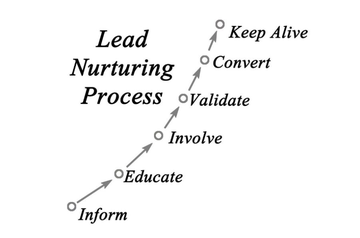6 Steps To Nurture Leads And Get More Sales
Would you like to know how to convince a customer to buy a product? In a previous article, I explained how the key to selling more products and services is to create happy customers who Know, Like and Trust (KLT) you.
If you want to learn how to convince customers to buy your product, you need to understand how to find, qualify and nurture the ideal prospects or leads that you can convert into paying customers.
A sale happens with the customer first realizing that they have a problem, then searching for different solutions to the problem, after which they decide on a solution that matches their needs and, finally, make the purchase.
As a seller, if you hope to convince your prospect or lead that your product is the solution to their problem, you need to be involved with them at every step of the customer buying process or buying cycle.
As a SHECO Partner, when you're selling a product or service, you want your customer to feel good about the experience so they’ll write you a glowing review and buy from you again and again.
According to CAERT, Inc., one of the best ways to nurture the customer relationship and create customer delight is to use a six-step selling process. The customer journey’s 6 basic selling steps include:
- Find and qualify prospects
- Nurture leads
- Make your presentation
- Answer their objections
- Close the sale
- Follow-up with customers
The steps below explain how to convince customers to buy your product by using lead-nurturing best practices in this six-step selling process.
#1. How to find and qualify prospects online
The first step in your lead nurturing strategy of finding and qualifying prospects starts with the process of preparing yourself for interacting with your potential customer.
This involves learning all about the product you’re going to sell and also learning about your ideal customer’s personality and buying preferences, so you can anticipate their needs better. The key to good prospecting is searching for ideal customers who need your product.
Qualifying involves evaluating whether your customer is worth pursuing, based on whether they can afford your product if they are the decision-maker, and whether they are ready to buy now.
Also Read: Know, Like and Trust (KLT) - The Key To Creating Happy Customers
You can find prospects online through communities and social media networks where those having common interests gather to share information and opinions.
Social media communities - like those on SHEROES, Facebook Groups, and Online Forums - are good places to connect with prospects that may need the products or services you’re selling.
You can qualify your prospects by following their conversations in these communities, seeing what topics they discuss, what questions they ask and which brands they mention.
You can also create your own discussion thread by using open-ended questions, where you could share a problem (such as the one that your product or service solves) and ask the community what solutions they recommend.
Be active in the communities. Be open, share about yourself and be authentic. Always add value, share useful information, and don’t try to sell or spam the community with promotional posts. It will destroy trust and make users wary of you.
#2. How to nurture leads online
When you approach a prospect or lead, it’s important to make a good first impression, get their trust and establish a relationship or connection. If you’re not successful in nurturing customer relationships, it’s very unlikely that they will buy from you.
But what does nurturing mean in a relationship with a lead or prospect? What is lead nurturing and how to nurture a lead so you can convert them to a new customer?
Learning how to nurture a new relationship with a lead means you must approach them with the intention of learning more about them, not with the intention of pushing your product on them or talking about yourself.
Spend some time listening to their stories and learning about their concerns. Ask questions and put them at ease. When you show genuine concern and build rapport without trying to sell them anything, they will begin to trust you.
Also Read: 10 Secrets Of Successful SHECO Entrepreneurs
If you’re wondering how to do lead nurturing in the age of social distancing, there are many free, easy-to-use customer engagement tools - such as Whatsapp, Facebook Messenger, Google Chat and Zoom - that allow you to approach a prospect and have conversations online from your mobile phone.
You can also use free tools like Google Drive, Dropbox and Gmail to share information - such as product catalogues, brochures and videos - with your prospects. You don’t even have to meet them in person if you prefer not to.
#3. How to make your presentation
Most sellers focus on a product’s features and advantages when trying to sell a product to a prospect. Describing your product’s features and attributes do appeal to the logical part of your prospect’s brain.
But, according to Harvard professor Gerald Zaltman, human beings are not as logical as we might imagine, and emotion is what really drives 95% of purchasing behaviors.
So, when marketing a product to a consumer, it's most effective to target their subconscious mind. If you want the consumer to remember your product or brand, you must make them feel engaged and excited by their interaction with you.
You must focus not only on the features of the product, but also sell the benefits and the emotional response or feeling a customer will achieve by using the product.
#4. How to handle objections
Knowing how to get customers to buy your product also requires the skill of answering objections that commonly come up during the sales conversation.
Your customer may have some issues that are holding them back from making the purchase and it’s important that you identify these objections and answer them in a way that changes the customer’s mind or gives them more information if they require it.
It can help to practice these objections - and your answers to them - with a friend or family member before you actually have a sales conversation with your prospect.
Some objections are not necessarily what they seem to be. Common objections around not being able to afford a product or having to ask someone else first, usually have to do with a lack of trust in the product or in you.
You may have to work on creating better trust between you and the prospect before they are willing to buy from you. Don’t take objections as a rejection or a personal slight. Remain calm and polite, ask questions, and try to understand their genuine concerns before you come up with an answer.
#5. How to close the sale
Does your prospect or lead seem to be interested and ready to buy? Now you must ask for the sale. Many sellers hesitate to close the sale because they’re afraid of coming across as too eager or too mercenary.
But your customer is not going to make the move themselves, so you must ask them to do it. You can watch for cues that they’re ready to purchase and make your move when the time is right.
If you don’t take this final step and close the sale, all the work you’ve spent in finding, qualifying and nurturing the lead will go to waste.
#6. How to follow up with customers
So you’ve closed your first sale. Congratulations! But your work is not over. Your job now is to learn how to increase customer loyalty and turn a happy customer into an advocate.
Today, technology makes it easy for us to build a customer list and keep in touch with customers after the sale. You can do that easily with tools like WhatsApp and Gmail.
You must now follow up with your customers, ask them how they liked the product and your services as a seller. If they liked it and have nothing but praise, ask them to write you a review as a SHECO Partner.
Send them updates of new products or services that they may like, based on your understanding of their personality and lifestyle, and don’t spam them with information about products that they would never purchase.
Technology can help you keep in touch with and nurture your relationship with your customers, but it’s up to you to work on your customer communication and customer service skills if you want happy customers who will buy from you again and again.

















